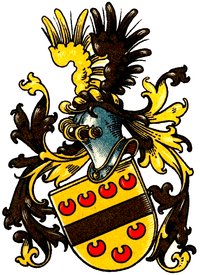Neheim (noble family)
Neheim (also Nehem ) was an old Westphalian noble family .
Property and history
Members of the family appear in the wake of the Counts of Arnsberg . From these they also carried possessions at Neheim and other places as fiefs.
The headquarters were in the town of the same name, Neheim . The family owned property in 1301 near Stockum (today City of Sundern), 1339 near Ofacker (?) Near Werl , 1382 near Oesthof, 1418 near Vynding (?) Near Arnsberg , 1455 near Bönkhausen , Budberg (today city Werl), 1507 with a few near Hagen and in 1590 near Westhofen . According to research by Albert K. Hömberg , the family owned in the Duchy of Westphalia near Menden (1276-1387). Stockum (1230–1461), Vellinghausen (1569–1670) and Neheim (1270–?). The Unter- or Niederwerries castle estate, which no longer existed and was later merged with Oberwerries castle , was owned by the family from the 15th century to 1677.
The family had a bad reputation in the 15th century because of numerous feuds and violent acts in the area of the former county of Arnsberg . In 1483, three brothers of the family complained to the Cologne Elector Hermann von Wied that the family had been ousted from their Stockum rule - which they themselves referred to as the county - by the electoral officials. They relied on old rights from 1300 from the time of Count Ludwig von Arnsberg . The possession of Stockum was so important because the income consisted not only of grain tithes, but also of lead and iron tithes from mining on the Erbenstein . The family had apparently set up their own mountain court for Stockum . The main task was to ensure that nobody could mine ore without the knowledge and permission of Neheim. This legal opinion collided with the sovereign claim to the mountain shelf based on the Golden Bull .
Johann Dietrich von Steinen names a Winholt, knight of the Teutonic Order and Drost, 1550 Drost in Livonia and a Hermann at the same time as Drost in Limburg as members of the family. Anna von Neheim zu Niederwerries (canon at Borghorst Abbey ) married Heinrich II von Droste-Hülshoff in 1629 . The family died out in 1715 with Johann Conrad Anton von Neheim on Oesthof and Ruhr.
coat of arms
The coat of arms shows a black bar in gold, above it in a row four and below it three (2: 1) red hearts. On the helmet with black and gold covers an open flight, gold on the right and black on the left.
Individual evidence
- ^ Anton Fahne: The Lords and Barons v. Hövel, along with the genealogy of the families from which they took their wives. Vol. 1, 1st and 2nd section Cologne, 1860 118f. [There numerous name bearers and their functions are also mentioned. Confusion with other families with similar names is possible]
- ^ Ernst Heinrich Kneschke: New General German Adels Lexicon. Vol. 6. Leipzig, 1865 p. 460
- ^ Albert K. Hömberg: Historical news about noble seats and manors in the Duchy of Westphalia and their owners - register. Münster, 2013 (Materials from the Historical Commission for Westphalia, PDF file)
- ^ Winfried Reininghaus / Reinhard Köhne: Mining, smelting and hammer works in the Duchy of Westphalia in the Middle Ages and the early modern period. Münster, 2008 p. 67 f.
- ^ Johann Dietrich von Steinen: Westphalian history part 1. Lemgo, 1755 p. 1661
- ↑ Wilderich von Droste zu Hülshoff : 900 years Droste zu Hülshoff . Verlag LPV Hortense von Gelmini, Horben 2018, ISBN 978-3-936509-16-8
literature
- Ernst Heinrich Kneschke: New General German Adels Lexicon. Volume 6. Leipzig, 1865 p. 460
- Albert K. Hömberg : Historical news about aristocratic seats and manors in the Duchy of Westphalia and their owners. Issue 1: Parishes of Hüsten and Neheim. Münster, 1969 pp. 87-89.
